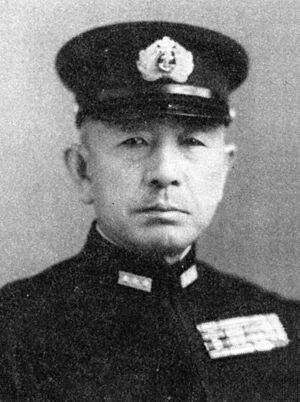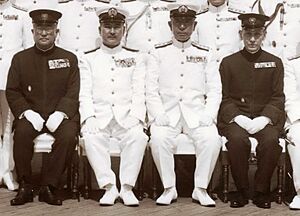Mineichi Koga facts for kids
Quick facts for kids
Mineichi Koga
|
|
|---|---|

Admiral Koga Mineichi (1942-44)
|
|
| Native name |
古賀 峯一
|
| Born | September 25, 1885 Arita, Saga, Japan |
| Died | March 31, 1944 (aged 58) near Davao, Second Philippine Republic |
| Allegiance | |
| Service/ |
|
| Years of service | 1906–1944 |
| Rank | |
| Commands held | Aoba, Ise, Naval Intelligence Bureau, Weapons and Mobilization Bureau, 7th Squadron, Training Fleet, Vice-chief of Navy General Staff, 2nd Fleet, China Area Fleet, Yokosuka Naval District, Combined Fleet |
| Battles/wars | |
| Awards | Order of the Sacred Treasures, 1st class Order of the Rising Sun, 1st class Order of the Golden Kite, 1st class Knight's Cross of the Iron Cross |
Mineichi Koga (古賀 峯一, Koga Mineichi, 25 September 1885 – 31 March 1944) was a very important Japanese naval officer. He became a Marshal Admiral, which is the highest rank in the Imperial Japanese Navy. He was also the commander-in-chief, or top leader, of Japan's main navy group, the Combined Fleet.
Contents
Life and Career
Early Years and Training
Mineichi Koga was born in 1885 in a town called Arita in Japan. When he was young, he joined the Imperial Japanese Naval Academy in 1906. He was a very good student, graduating 14th in his class of 176 cadets.
After graduating, he started his naval career as a midshipman. He sailed on a training ship called the Matsushima. This ship took him on a long journey to many places around the world, like Honolulu, Wellington, and Singapore.
Rising Through the Ranks
Koga continued to serve on different ships, slowly moving up in rank. He became an ensign, then a sub-lieutenant, and later a lieutenant. He also went to Japan's Naval War College to study more about naval strategy.
After his studies, he worked in staff jobs on land. In 1920, he became an officer living in France. He later returned to Japan and served as an executive officer on the cruiser Kitakami.
In 1926, Koga was promoted to captain. He went back to France to work as a naval attaché in Paris. This meant he was a naval expert who worked at the Japanese embassy there.
When he returned to Japan in 1930, he took command of large warships. He was the captain of the heavy cruiser Aoba and later the battleship Ise. By 1932, he was promoted to rear admiral. He then became the head of the Navy's Intelligence Division, which gathers important information.
In 1936, Koga became the second-in-command of the Navy General Staff and was promoted to vice admiral. This was just before the Second Sino-Japanese War began in 1937.
By 1941, he was in charge of the China Area Fleet. Koga had some concerns about going to war with the United States. He also believed that battleships were more important than aircraft carriers, which was a common idea at the time.
Pacific War Role
Battle of Hong Kong
When the Pacific War started, Koga led the naval operations during the Battle of Hong Kong. This battle took place in December 1941.
Leading the Combined Fleet

In April 1943, a very important Japanese admiral named Isoroku Yamamoto died. Mineichi Koga was chosen to take his place as the Commander in Chief of the Combined Fleet. His main ship was the battleship Musashi.
Koga tried to make the Japanese navy stronger. He reorganized the Combined Fleet into groups built around aircraft carriers, similar to how the United States Navy operated. He also planned to use land-based planes to work with the carriers.
He wanted to launch a strong counterattack against the Americans. However, Japan lost many planes and ships in battles. This forced the Japanese to pull back from some areas. Koga then decided to save his remaining forces for one big, decisive battle. This plan was called the "Z plan".
He also tried to improve how Japan protected its supply ships from American submarines. This was important because U.S. submarines were sinking many Japanese merchant ships.
Death and Legacy
Mineichi Koga died on March 31, 1944. He was flying in a large Kawanishi H8K flying boat during a typhoon. His plane crashed between Palau and Davao while he was moving the Combined Fleet headquarters.
His Chief of Staff, Vice Admiral Shigeru Fukudome, survived a crash in a different plane. He was captured by Filipino fighters. During his capture, Koga's secret battle plans were found by the Allies.
Koga's death was kept a secret by Japan until May 1944. He was then officially replaced by Admiral Soemu Toyoda. Koga was given the highest rank, Marshal Admiral, after his death. He also received a state funeral, which is a special ceremony for important national figures. His grave is in the Tama Cemetery near Tokyo.
See also
 In Spanish: Mineichi Koga para niños
In Spanish: Mineichi Koga para niños

